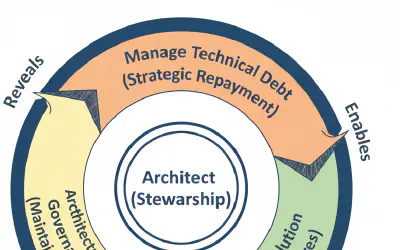The Architect's Toolbox
Choosing Your Foundational Style
Part of the From Patterns to Practice series
Introduction: From “Why” to “How”
In our last post, you did the critical work of an architect: you took the vague, conflicting pressures at CityPulse and translated them into a concrete, measurable set of architectural drivers. You know the what. Now, you have to decide on the how.
This means choosing a foundational Architectural Style. It’s important to be precise here. An Architectural Style is the highest-level decision about the structure of your system. Lower-level Architectural Patterns are specific solutions used within a style.
The world of architectural styles is vast, including classics like Layered, Client-Server, and more specialized ones like Space-Based architecture. However, for most modern applications, the most fundamental and contentious decision you will face revolves around system distribution. How will you deploy your code and how will its pieces communicate?
The three styles that provide the clearest answers to this question are the Monolithic, Microservices, and Event-Driven styles. By analyzing these three, you will learn the core trade-offs that dominate modern system design. We will focus on these for now, and explore others in future posts.
Your most direct path is the Monolithic style—a single, unified application. All code for every part of the business would live in one deployable unit. How does this choice stack up against your specific drivers for CityPulse?
It’s an excellent fit for your Time-to-Market driver. The simplicity of a single codebase and deployment makes it undeniably the fastest option to meet that three-month deadline. For your Reliability driver, it also performs well; a ticket purchase can be a single, atomic database transaction, which is inherently more reliable than a distributed one.
However, it’s a poor fit for your critical Throughput Scalability driver. This isn’t to say a monolith can’t scale; you can always run more instances. The problem is that this scaling is indiscriminate and inefficient. To handle the load on the small Ticketing part of your application, you’re forced to replicate and pay for the entire monolith, including the idle User Profile and Event Organizer modules. You’re scaling the whole to serve a tiny, overloaded part.
Architect's Log
There’s a pervasive myth in our industry that “monoliths don’t scale” and “microservices do.” It’s a dangerous oversimplification. The truth is that you pay a “scaling tax” either way. With a monolith, you pay by scaling inefficiently at the application level. With microservices, you pay a heavy, upfront tax in infrastructure and operational complexity for every single service. The real architectural question isn’t “which one scales?”, but “which scaling tax am I more willing to pay right now?”From a domain perspective, you’d implement the different parts of the CityPulse business as internal modules. The key architectural challenge here is preventing those module boundaries from decaying over time into a “big ball of mud.”
The Second Tool: The Microservices Style
To directly address your scalability driver, you can consider the Microservices style. What are the real-world consequences of this choice for CityPulse?
This style is a perfect fit for your Throughput Scalability driver. You can create a TicketingService and scale it independently to meet the 1,000 purchases/sec target. This also means the Performance for other users is protected, as the rest of the site is isolated from the ticket sale frenzy.
But this introduces a different kind of waste that is often ignored: the infrastructure overhead of each service. Each of your small services needs its own container, its own runtime, and its own monitoring, creating a “microservice tax.” You must consider whether the cost of this distributed overhead across many small services is actually greater than the cost of replicating the few, lightweight modules within your monolith. For a very small project, a lean monolith can sometimes be more resource-efficient overall.
This is a common trap that leads to what is often called a “distributed monolith”. The post on the “Secret to Modular, Deployable Architecture”, which introduces the concept of the Architectural Quantum explores this anti-pattern in detail.
Furthermore, this style is a very poor fit for your Time-to-Market goal. The upfront complexity of creating a distributed system makes the three-month deadline nearly impossible. It also scores lower on Reliability. A single ticket purchase might now require synchronous calls between three different services, introducing temporal coupling that significantly increases the chances of failure.
The Third Tool: The Event-Driven Style
Both previous styles present a stark trade-off. Let’s analyze the third candidate, the Event-Driven style, which offers a different way to think about communication.
This architecture is an excellent fit for your Throughput Scalability and Performance drivers. Your purchase endpoint could simply accept a request, write it to a queue as a TicketPurchaseRequested event, and respond immediately. This allows the system to absorb massive traffic spikes. It also scores very high on Reliability. By eliminating temporal coupling, the Ticketing process can continue even if the Notifications service is down.
Like the microservices style, however, it is a poor fit for your Time-to-Market driver. It requires significant upfront investment in message brokers and, more importantly, requires your team to master a new, asynchronous way of thinking. From a domain perspective, the workflow of a ticket purchase maps very naturally to a sequence of events, but the challenge is managing eventual consistency and debugging a process that is now spread across multiple, disconnected services.
Architect’s Log: Of all the styles, Event-Driven Architecture is the easiest to get wrong. The allure of decoupling is powerful, but I’ve seen teams create incomprehensible ‘chains of events’ that are impossible to debug. If you can’t clearly trace your core business workflows, you haven’t designed a resilient system; you’ve designed chaos. My rule is: don’t even consider EDA unless you have a rock-solid plan for observability and distributed tracing from day one.
Key Takeaways:
- The first major architectural decision is choosing a foundational Architectural Style that defines your system’s deployment and communication structure.
- Analyze candidate styles against your specific, measurable business drivers, not generic pros and cons.
- Always consider the nuanced, real-world trade-offs. “Monoliths don’t scale” is a lazy generalization; the real issue is inefficient scaling. The “microservice tax” for infrastructure overhead is a real cost that can make them less efficient for smaller projects.
Setting the Stage for a Decision
You’ve now completed a professional analysis, moving beyond buzzwords to a nuanced understanding of how each architectural style interacts with your specific business problem. The dilemma is clear: the Monolith wins on speed, the Microservices style wins on organizational scale, and the Event-Driven style wins on resilience and absorbing load.
So, how do you choose? How do you move beyond this qualitative discussion and make a formal, data-driven, and justifiable decision?
To break the tie, you need to quantify this analysis and apply your business priorities. In our next post, we will introduce the final analytical tools in our framework—the Pattern Profiling Scorecard and the Weighted Scoring Matrix—to turn this analysis into a final, data-driven decision.
Further Reading
- Fundamentals of Software Architecture by Mark Richards and Neal Ford. A comprehensive and accessible overview of many architectural styles and patterns.
- “MonolithFirst” by Martin Fowler. The classic and influential article arguing for why starting with a monolith is often a pragmatic choice.
- Building Microservices, 2nd Edition by Sam Newman. The canonical book on the microservices architectural style.
- “What do you mean by ‘Event-Driven’?” by Martin Fowler. A crucial article that clarifies the different patterns and motivations that fall under the broad EDA umbrella.



